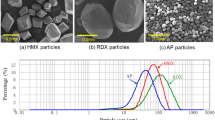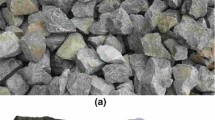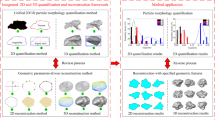Abstract
Particle shape governs the macro-mechanical behavior of high explosives. This study develops 3D computational geometry techniques to determine commonly used sphericity and roundness definitions of typical high explosive particles, including HMX (octahydro-1,3,5,7-tetranitro- 1,3,5,7-tetrazocine), RDX (1,3,5-Trinitroperhydro-1,3,5-triazine), and CL-20 (2,4,6,8,10,12-hexanitro-2,4,6,8,10,12-hexaazaisowurtzitane). This technique can automatically determine principal dimensions, volume, surface area, minimum circumscribed sphere, maximum inscribed sphere, and the 3D convex hull of 3D particle geometries and determine commonly used 3D sphericity descriptors of high explosive particles. This technique can also automatically identify corners on the 3D particle surface, fit appropriate spheres to these corners, and compute Wadell’s roundness of high explosive particles. This study demonstrates that the qualities of 3D particle geometries affect the computational results of particle sphericity and roundness descriptors of high explosives. These descriptors display a hierarchy of resistance to the effects of low image quality. Therefore, the minimum requirements for ensuring reliable shape characterization of these parameters are established for high explosives. This study systematically compares 2D and 3D particle shape characterizations of around 15,000 particles from three high explosives (HMX, RDX, and CL-20). Results show that 2D sphericity and rounded definitions either underestimate the corresponding 3D definitions or vary within large ranges leading to uncertainties for inferring 3D particle characteristics from 2D images of high explosives.
















Similar content being viewed by others
Data availability
All data, models, or code that support the findings of this study are available from the corresponding author upon reasonable request.
References
Chun S, Roy S, Nguyen YT et al (2020) Deep learning for synthetic microstructure generation in a materials-by-design framework for heterogeneous energetic materials. Sci Rep 10:1–15. https://doi.org/10.1038/s41598-020-70149-0
Zhou Z, Chen P, Huang F, Liu S (2011) Experimental study on the micromechanical behavior of a PBX simulant using SEM and digital image correlation method. Opt Lasers Eng 49:366–370. https://doi.org/10.1016/j.optlaseng.2010.11.001
Field JE, Swallowe GM, Heavens SN (1982) Ignition mechanisms of explosives during mechanical deformation. Proc R Soc Lond A 382:231–244. https://doi.org/10.1098/rspa.1982.0099
Liu YR, Hu XM, Duan ZP, Zhang ZY (2019) A mesoscopic reaction rate model for shock-to-detonation of PBX explosives having different mean particle sizes. Shock Waves 29:559–571. https://doi.org/10.1007/s00193-018-0875-4
Peterson PD, Avilucea GR, Bishop RL, Sanchez JA (2007) Individual contributions of friction and impact on non-shock initiation of high explosives. In: AIP conference proceedings, vol 955, pp 983–986. https://doi.org/10.1063/1.2833296
Winter R, Field JE (1975) The role of localized plastic flow in the impact initiation of explosives. Proc R Soc Lond A Math Phys Sci 343:399–413. https://doi.org/10.1098/rspa.1975.0074
Austin RA, Barton NR, Reaugh JE, Fried LE (2015) Direct numerical simulation of shear localization and decomposition reactions in shock-loaded HMX crystal. J Appl Phys. https://doi.org/10.1063/1.4918538
Cox EA (1927) A method of assigning numerical and percentage values to the degree of roundness of sand grains. J Paleontol 1:179–183
Tickell FG (1931) The examination of fragmental rocks. Stanford University Press, Stanford
Wadell H (1932) Volume, shape, and roundness of rock particles. J Geol 40:443–451. https://doi.org/10.1086/623964
Wadell H (1933) Sphericity and roundness of rock particles. J Geol 41:310–331. https://doi.org/10.1086/624040
Wadell H (1935) Volume, shape, and roundness of quartz particles. J Geol 43:250–280. https://doi.org/10.1086/624298
Krumbein WC (1941) Measurement and geological significance of shape and roundness of sedimentary particles. SEPM J Sediment Res 11:64–72. https://doi.org/10.1306/d42690f3-2b26-11d7-8648000102c1865d
Riley NA (1941) Projection sphericity. SEPM J Sediment Res. https://doi.org/10.1306/d426910c-2b26-11d7-8648000102c1865d
Krumbein WC, Sloss LL (1951) Stratigraphy and sedimentation. San Francisco, W.H, Freeman and Company
Kuenen PhH (1956) Experimental abrasion of pebbles: 2. Rolling by current. J Geol 64:336–338
Aschenbrenner BC (1956) A new method of expressing particle sphericity. J Sediment Res 26:15–31. https://doi.org/10.1306/74D704A7-2B21-11D7-8648000102C1865D
Williams EM (1965) A method of indicating pebble shape with one parameter. J Sediment Res 35:993–996
Dobkins JE, Folk RL (1970) Shape development on Tahiti-Nui. J Sediment Petrol 40:1167–1203
Barrett PJ (1980) The shape of rock particles, a critical review. Sedimentology 27:291–303
Mora CF, Kwan AKH (2000) Sphericity, shape factor, and convexity measurement of coarse aggregate for concrete using digital image processing. Cem Concr Res 30:351–358. https://doi.org/10.1016/S0008-8846(99)00259-8
Santamarina JC, Cho GC (2004) Soil behaviour: the role of particle shape. In: Advances in geotechnical engineering: The Skempton conference. Thomas Telford, London, pp 604–617
Kuo C-Y, Freeman R (2000) Imaging indices for quantification of shape, angularity, and surface texture of aggregates. Transp Res Rec J Transp Res Board 1721:57–65. https://doi.org/10.3141/1721-07
Cavarretta I, O’Sullivan C, Coop MR (2010) The influence of particle characteristics on the behaviour of coarse grained soils. Geotechnique 60:413–423. https://doi.org/10.1680/geot.2010.60.6.413
Otsubo M, O’sullivan C, Sim WW, Ibraim E (2015) Quantitative assessment of the influence of surface roughness on soil stiffness. Géotechnique 65:694–700. https://doi.org/10.1680/geot.14.T.028
Senetakis K, Coop MR, Todisco MC (2013) The inter-particle coefficient of friction at the contacts of Leighton Buzzard sand quartz minerals. Soils Found 53:746–755. https://doi.org/10.1016/j.sandf.2013.08.012
Senetakis K, Coop MR, Todisco MC (2013) Tangential load–deflection behaviour at the contacts of soil particles. Géotechn Lett 3:59–66. https://doi.org/10.1680/geolett.13.00019
Senetakis K, Sandeep CS, Todisco MC (2017) Dynamic inter-particle friction of crushed limestone surfaces. Tribol Int 111:1–8. https://doi.org/10.1016/j.triboint.2017.02.036
Powers MC (1953) A new roundness scale for sedimentary particles. SEPM J Sediment Res. https://doi.org/10.1306/d4269567-2b26-11d7-8648000102c1865d
Zheng J, Hryciw RD (2015) Traditional soil particle sphericity, roundness and surface roughness by computational geometry. Géotechnique. https://doi.org/10.1680/geot.14.P.192
Zhou B, Wang J (2016) Generation of a realistic 3D sand assembly using X-ray micro-computed tomography and spherical harmonic-based principal component analysis. Int J Numer Anal Meth Geomech 41:93–109. https://doi.org/10.1002/nag.2548
Mukunoki T, Miyata Y, Mikami K, Shiota E (2016) X-ray CT analysis of pore structure in sand. Solid Earth 7:929–942. https://doi.org/10.5194/se-7-929-2016
Kawamoto R, Andò E, Viggiani G, Andrade JE (2018) All you need is shape: predicting shear banding in sand with LS-DEM. J Mech Phys Solids 111:375–392. https://doi.org/10.1016/j.jmps.2017.10.003
Andrade JE, Lim KWK-W, Avila CF et al (2012) Granular element method for computational particle mechanics. Comput Methods Appl Mech Eng 214–244:262–274. https://doi.org/10.1016/j.cma.2012.06.012
Sun Q, Zheng J, Li C (2019) Improved watershed analysis for segmenting contacting particles of coarse granular soils in volumetric images. Powder Technol 356:295–303. https://doi.org/10.1016/j.powtec.2019.08.028
Sun Q, Zheng J (2019) Two-dimensional and three-dimensional inherent fabric in cross-anisotropic granular soils. Comput Geotech 116:103197. https://doi.org/10.1016/j.compgeo.2019.103197
Yang J, Luo XD (2015) Exploring the relationship between critical state and particle shape for granular materials. J Mech Phys Solids 84:196–213. https://doi.org/10.1016/j.jmps.2015.08.001
Anochie-boateng JK, Komba JJ, Mvelase GM (2013) Three-dimensional laser scanning technique to quantify aggregate and ballast shape properties. Constr Build Mater 43:389–398. https://doi.org/10.1016/j.conbuildmat.2013.02.062
Lanaro F, Tolppanen P (2002) 3D characterization of coarse aggregates. Eng Geol 65:17–30. https://doi.org/10.1016/S0013-7952(01)00133-8
Zheng J, Hryciw RD (2014) Soil particle size characterization by stereophotography. In: Geotechnical special publication, pp 64–73
Zheng J, Hryciw R, Ohm H-S (2014) Three-dimensional translucent segregation table (3D-TST) test for soil particle size and shape distribution. In: Soga K, Kumar K, Biscontin G, Kuo M (eds) Geomechanics from micro to macro. CRC Press, pp 1037–1042
Zheng J, Hryciw RD (2017) Soil particle size and shape distributions by stereophotography and image analysis. Geotech Test J 40:317–328. https://doi.org/10.1520/GTJ20160165
Sun Q, Zheng Y, Li B et al (2019) Three-dimensional particle size and shape characterization using structural light. Geotech Lett 9:1–7. https://doi.org/10.1680/jgele.18.00207
Moore JD, Barnes BC, Izvekov S et al (2016) A coarse-grain force field for RDX: density dependent and energy conserving. J Chem Phys 144:1–11. https://doi.org/10.1063/1.4942520
Shekhar H (2012) Studies on empirical approaches for estimation of detonation velocity of high explosives. Central Eur J Energ Mater 9:39–48
Kim DY, Kim KJ (2007) Solubility of cyclotrimethylenetrinitramine (RDX) in binary solvent mixtures. J Chem Eng Data 52:1946–1949. https://doi.org/10.1021/je7002463
Trott S, Nishino SF, Hawari J, Spain JC (2003) Biodegradation of the nitramine explosive CL-20. Appl Environ Microbiol 69:1871–1874. https://doi.org/10.1128/AEM.69.3.1871-1874.2003
Zhao B, Wang J, Coop MR et al (2015) An investigation of single sand particle fracture using x-ray micro-tomography. Geotechnique 65:625–641. https://doi.org/10.1680/geot.4.P.157
Coletti F, Benson MJ, Sagues AL et al (2014) Three-dimensional mass fraction distribution of a spray measured by X-ray computed tomography. J Eng Gas Turbines Power 136:1–8. https://doi.org/10.1115/1.4026245
Otsu N (1979) A threshold selection method from gray-level histograms. IEEE Trans Syst Man Cybern 9:62–66
Gray A, Abbena E, Salamon S (2006) Modern differential geometry of curves and surfaces with mathematica, 3rd edn. Chapman & Hall/CRC
Acknowledgements
This work was financially supported by the Fund from State Administration of Science, Technology and Industry for National Defence, PRC (WDZCKYXM20190101), and the National Natural Science Foundation of China (51769028), Beijing Institute of Structure and Environment Engineering Fund (BQ2019001).
Author information
Authors and Affiliations
Corresponding authors
Ethics declarations
Conflict of interest
The authors declare that they have no known competing financial interests or personal relationships that could have appeared to influence the work reported in this paper.
Additional information
Publisher's Note
Springer Nature remains neutral with regard to jurisdictional claims in published maps and institutional affiliations.
Rights and permissions
Springer Nature or its licensor (e.g. a society or other partner) holds exclusive rights to this article under a publishing agreement with the author(s) or other rightsholder(s); author self-archiving of the accepted manuscript version of this article is solely governed by the terms of such publishing agreement and applicable law.
About this article
Cite this article
Jia, X., Liu, Z., Han, Y. et al. Sphericity and roundness for three-dimensional high explosive particles by computational geometry. Comp. Part. Mech. 10, 817–836 (2023). https://doi.org/10.1007/s40571-022-00524-3
Received:
Revised:
Accepted:
Published:
Issue Date:
DOI: https://doi.org/10.1007/s40571-022-00524-3




